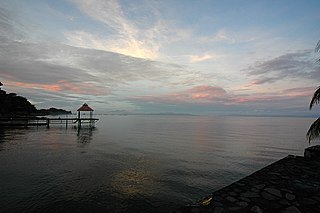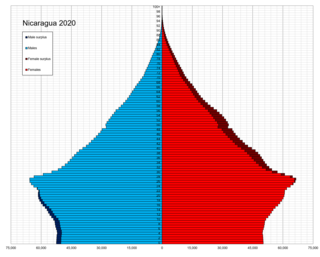
Central America is a region of the Americas. It is bordered by Mexico to the north, Colombia to the south, the Caribbean Sea to the east, and the Pacific Ocean to the west. Central America consists of seven countries: Belize, Costa Rica, El Salvador, Guatemala, Honduras, Nicaragua, and Panama. Their combined population is estimated at 44.53 million (2016).

The Contras were the various U.S.-backed and funded right-wing rebel groups that were active from 1979 to 1990 in opposition to the Marxist Sandinista Junta of National Reconstruction Government in Nicaragua which came to power in 1979 following the Nicaraguan Revolution. Among the separate contra groups, the Nicaraguan Democratic Force (FDN) emerged as the largest by far. In 1987, virtually all contra organizations were united, at least nominally, into the Nicaraguan Resistance.

José Daniel Ortega Saavedra is a Nicaraguan revolutionary and politician serving as President of Nicaragua since 2007. Previously, he was leader of Nicaragua from 1979 to 1990, first as coordinator of the Junta of National Reconstruction (1979–1985) and then as President of Nicaragua (1985–1990). After the retirement of Fidel Castro in 2008, Ortega is one of the longest-serving non-royal rulers in the world and the longest serving non-royal leader in the Americas.

Lake Nicaragua or Cocibolca or Granada is a freshwater lake in Nicaragua. Of tectonic origin and with an area of 8,264 km2 (3,191 sq mi), it is the largest lake in Central America, the 19th largest lake in the world and the tenth largest in the Americas, slightly smaller than Lake Titicaca. With an elevation of 32.7 metres (107 ft) above sea level, the lake reaches a depth of 26 metres (85 ft). It is intermittently joined by the Tipitapa River to Lake Managua.

Nicaragua, officially the Republic of Nicaragua, is the largest country in the Central American isthmus, bordered by Honduras to the northwest, the Caribbean to the east, Costa Rica to the south, and the Pacific Ocean to the southwest. Managua is the country's capital and largest city and is also the third-largest city in Central America, behind Tegucigalpa and Guatemala City. The multi-ethnic population of six million includes people of mestizo, indigenous, European and African heritage. The main language is Spanish. Indigenous tribes on the Mosquito Coast speak their own languages and English.

According to the 2019 revision of the World Population Prospects, Nicaragua has a population of 6,465,501. Whites and Mestizos and tribally unaffiliated Native Americans combined make up about 86% of the population. The remainder of the Nicaraguan population is 9% English-speaking Afro-Nicaraguans, and 5% Tribal Native American.

The economy of Nicaragua is focused primarily on the agricultural sector. Nicaragua itself is the least developed country in Central America, and the second poorest in the Americas by nominal GDP. In recent years, under the administrations of Daniel Ortega, the Nicaraguan economy has expanded somewhat, following the Great Recession, when the country's economy actually contracted by 1.5%, due to decreased export demand in the American and Central American markets, lower commodity prices for key agricultural exports, and low remittance growth. The economy saw 4.5% growth in 2010 thanks to a recovery in export demand and growth in its tourism industry. Nicaragua's economy continues to post growth, with preliminary indicators showing the Nicaraguan economy growing an additional 5% in 2011. Consumer Price inflation have also curtailed since 2008, when Nicaragua's inflation rate hovered at 19.82%. In 2009 and 2010, the country posted lower inflation rates, 3.68% and 5.45%, respectively. Remittances are a major source of income, equivalent to 15% of the country's GDP, which originate primarily from Costa Rica, the United States, and European Union member states. Approximately one million Nicaraguans contribute to the remittance sector of the economy.

The Nicaraguan Canal, formally the Nicaraguan Canal and Development Project was a proposed shipping route through Nicaragua to connect the Caribbean Sea with the Pacific Ocean. Scientists were concerned about the project's environmental impact, as Lake Nicaragua is Central America's key freshwater reservoir while the project's viability was questioned by shipping experts and engineers.

The Sandinista National Liberation Front is a socialist political party in Nicaragua. Its members are called Sandinistas[sandiˈnistas] in both English and Spanish. The party is named after Augusto César Sandino, who led the Nicaraguan resistance against the United States occupation of Nicaragua in the 1930s.

Managua is the capital and largest city of Nicaragua, and the center of an eponymous department. Located on the southwestern shore of Lake Managua and inside the Managua Department, it has an estimated population of 1,055,247 in 2020 within the city's administrative limits and a population of 1,401,687 in the metropolitan area, which additionally includes the municipalities of Ciudad Sandino, El Crucero, Nindirí, Ticuantepe and Tipitapa.

The Mosquito Coast, also known as the Mosquitia, Mosquito Shore and the Mosquito Kingdom, historically included the area along the eastern coast of present-day Nicaragua and Honduras. It formed part of the Western Caribbean Zone. It was named after the local Miskitu Nation and was long dominated by British interests. The Mosquito Coast was militarily incorporated into Nicaragua in November 1894; however, in 1960, the northern part was granted to Honduras by the International Court of Justice.

The president of Nicaragua, officially known as the President of the Republic of Nicaragua, is the head of state and head of government of Nicaragua. The office was created in the Constitution of 1854. From 1825 until the Constitution of 1838, the head of state of Nicaragua was styled simply as Head of State, and from 1838 to 1854 as Supreme Director.

William Walker was an American physician, lawyer, journalist and mercenary who organized several private military expeditions into Mexico and Central America with the intention of occupying the local nations and establishing slave-hold colonies, an enterprise then known as "filibustering". Walker usurped the presidency of Nicaragua in July 1856 at the request of Liberal Democratic Party of Nicaragua and ruled until May 1, 1857, when he was forced out of the presidency and the country by a coalition of Central American armies. He returned in an attempt to re-establish his control of the region, but was captured and executed by the government of Honduras in 1860 while escaping the Costa Rican army after being defeated by General Cañas in the battles of Rivas and Santa Rosa.

The Nicaraguan Revolution encompassed the rising opposition to the Somoza dictatorship in the 1960s and 1970s, the campaign led by the Sandinista National Liberation Front (FSLN) to oust the dictatorship in 1978–79, the subsequent efforts of the FSLN to govern Nicaragua from 1979 to 1990, and the Contra War, which was waged between the FSLN-led government of Nicaragua and the United States–backed Contras from 1981 to 1990. The revolution marked a significant period in the history of Nicaragua and revealed the country as one of the major proxy war battlegrounds of the Cold War, attracting much international attention.

The Nicaragua national football team represents Nicaragua in men's international football and is controlled by the Nicaraguan Football Federation. Nicaragua achieved its first qualification to a major international competition in 2009, as they qualified for the 2009 Gold Cup as the last entrant from Central America, after a 2–0 win over Guatemala in the fifth place match in the 2009 Nations Cup. However, the team has never qualified for the FIFA World Cup.

The United States occupation of Nicaragua from 1912 to 1933 was part of the Banana Wars, when the US military invaded various Latin American countries from 1898 to 1934. The formal occupation began in 1912, even though there were various other assaults by the U.S. in Nicaragua throughout this period. American military interventions in Nicaragua were designed to stop any other nation except the United States of America from building a Nicaraguan Canal.
Miss Nicaragua is an American beauty pageant that has been held annually since 1955 to select the entrant from Nicaragua in the Miss Universe pageant. Until 2001 when the model agency Siluetas announces that the most important beauty pageant in the country will be operated by Karen Celebertti.

Friendly Bilateral relations now exist between Nicaragua and the United States. However, in the 19th and 20th centuries, tensions were high and American intervention was frequent. In the 1980s, the U.S, waged an undeclared war against the left-wing Sandinista movement until it was defeated in an election in 1990.

The COVID-19 pandemic in Nicaragua is part of the worldwide pandemic of coronavirus disease 2019 caused by severe acute respiratory syndrome coronavirus 2. The virus was shown to have spread to Nicaragua when the first case, a Nicaraguan citizen who had returned to the country from Panama, was confirmed on 18 March 2020.